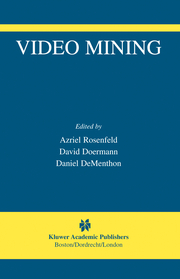Detailansicht
Video Mining
The International Series in Video Computing 6
ISBN/EAN: 9781402075490
Umbreit-Nr.: 1622695
Sprache:
Englisch
Umfang: ix, 340 S., 70 s/w Illustr.
Format in cm:
Einband:
gebundenes Buch
Erschienen am 31.08.2003
- Zusatztext
- Traditionally, scientific fields have defined boundaries, and scientists work on research problems within those boundaries. However, from time to time those boundaries get shifted or blurred to evolve new fields. For instance, the original goal of computer vision was to understand a single image of a scene, by identifying objects, their structure, and spatial arrangements. This has been referred to as image understanding. Recently, computer vision has gradually been making the transition away from understanding single images to analyzing image sequences, or video Video understanding deals with understanding of video understanding. sequences, e.g., recognition of gestures, activities, facial expressions, etc. The main shift in the classic paradigm has been from the recognition of static objects in the scene to motion-based recognition of actions and events. Video understanding has overlapping research problems with other fields, therefore blurring the fixed boundaries. Computer graphics, image processing, and video databases have obvi ous overlap with computer vision. The main goal of computer graphics is to generate and animate realistic looking images, and videos. Re searchers in computer graphics are increasingly employing techniques from computer vision to generate the synthetic imagery. A good exam pIe of this is image-based rendering and modeling techniques, in which geometry, appearance, and lighting is derived from real images using computer vision techniques. Here the shift is from synthesis to analy sis followed by synthesis. Image processing has always overlapped with computer vision because they both inherently work directly with images.
- Kurztext
- Intended for practitioners and academicians in the fields of multimedia search engines. This book gives insights to researchers and non-specialists who want to understand the principles applied by the multimedia search engines that are deployed on the Internet, in studios' multimedia asset management systems, and in video-on-demand systems.
- Autorenportrait
- Inhaltsangabe1. Efficient Video Browsing; A. Amir, S. Srinivasan, D. Ponceleon. 2. Beyond Key-Frames: The Physical Setting as a Video Mining Primitive; A. Aner-Wolf, J.R. Kender. 3. Temporal Video Boundaries; N. Dimitrova, L. Agnihotri, R. Jasinschi. 4. Video Summarization using MPEG-7 Motion Activity and Audio Descriptors; A. Divakaran, K.A. Peker, R. Radhakrishnan, Ziyou Xiong, R. Cabasson. 5. Movie Content Analysis, Indexing and Skimming Via Multimodal Information; Ying Li, S. Narayanan, C.-C. Jay Kuo. 6. Video OCR: A Survey and Practitioner's Guide; R. Lienhart. 7. Video Categorization Using Semantics and Semiotics; Z. Rasheed, M. Shah. 8. Understanding the Semantics of Media; M. Slaney, D. Ponceleon, J. Kaufman. 9. Statistical Techniques for Video Analysis and Searching; J.R. Smith, Ching-Yung Lin, M. Naphade, A. (Paul) Natsev, B. Tseng. 10. Mining Statistical Video Structures; Lexing Xie, Shih-Fu Chang, A. Divakaran, Huifang Sun. 11. Pseudo-Relevance Feedback for Multimedia Retrieval; Rong Yan, A.G. Hauptmann, Rong Jin. Index.
